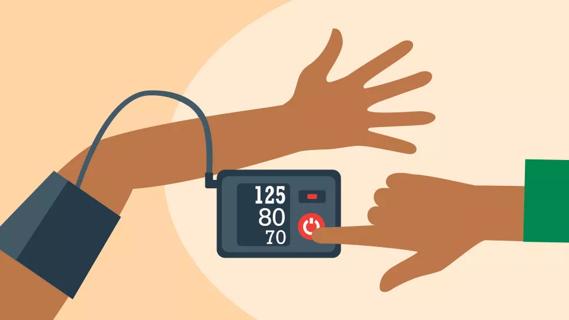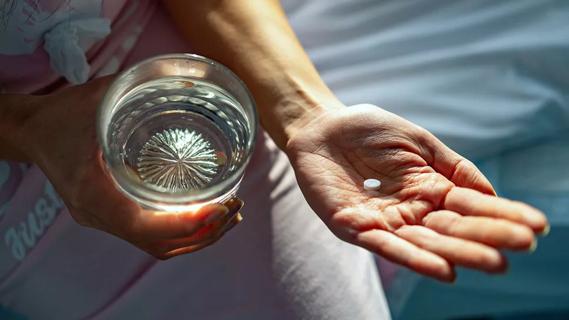Low blood pressure got you feeling down? Staying hydrated and wearing compression socks can help

If you’re dealing with low blood pressure (hypotension), it’s understandable if you feel forgotten. The condition just doesn’t get talked about much living in the shadows of high blood pressure (hypertension).
Advertisement
Cleveland Clinic is a non-profit academic medical center. Advertising on our site helps support our mission. We do not endorse non-Cleveland Clinic products or services. Policy
But low blood pressure (BP) can be a concern that deserves attention. It’s also a more common issue than you might think, particularly as people age.
So, how can you raise low blood pressure? Let’s find out from cardiologist Luke Laffin, MD.
Before we get into actual numbers, let’s look at what blood pressure numbers mean.
Blood pressure measures the force needed to pump blood throughout the vast network of blood vessels crisscrossing your body. That’s a 60,000-mile system of arteries, veins and smaller capillaries.
A blood pressure reading includes two numbers given in a unit of measurement called millimeters of mercury, or mmHg. (In case you were wondering, that’s a pressure unit equal to the pressure exerted by a column of mercury 1mm high at 0 degrees Celsius.)
These numbers indicate the pressure on blood vessels when your heart beats (systolic blood pressure) and rests (diastolic blood pressure). Systolic BP is always the first or top number.
Blood pressure below 120/80 mmHg is generally regarded as being in a healthy zone. Anything above that is considered high, which is a whole separate (and dangerous) issue we won’t get into here.
But if that first number consistently falls below 90, you may have low blood pressure, says Dr. Laffin. Low blood pressure, or hypotension, is typically defined as anything below 90/60 mmHg.
Advertisement
Low blood pressure isn’t always a cause for concern … but it could be. A sudden or drastic drop in BP could be a sign of an infection, illness or a reaction to medication, especially if you’re experiencing symptoms like:
“It’s context-dependent,” explains Dr. Laffin. “Many healthy people are walking around with blood pressure around 90 over 60, and they’re fine. The number unto itself is not dangerous. But if you’re symptomatic, that should be evaluated.”
Consistently low blood pressure can put added stress on your organs (including your heart) and bring a risk of injury-causing falls from dizziness or fainting. Here are four things you can do to nudge your BP a bit higher.
If you’re dehydrated, the loss of fluid in your body lowers your blood supply — and that leads to a drop in blood pressure. (Think of it like water in a hose, where turning the spigot to max flow increases the pressure and force of water coming out.)
The solution to this is relatively easy: Consume enough fluids to stay hydrated. As a starting point per day, it’s recommended that males take in 125 ounces (3.7 liters) of water and females consume 91 ounces (2.7 liters).
“More fluid brings more volume within the vasculature to boost low blood pressure,” explains Dr. Laffin. “It’s that simple.”
When it comes to adding sodium to your diet, most health advice comes with a no-no-no finger wag. Excess sodium (and salt) can contribute to issues such as heart disease and stroke, after all.
But sodium isn’t all bad. In fact, it’s an essential electrolyte and plays a key role in maintaining your body’s fluid levels. “It pulls fluid into your vasculature,” says Dr. Laffin.
So, if you have low blood pressure, sodium can bump it up.
The gentle squeeze offered by compression socks can nudge up low blood pressure by slightly narrowing your blood vessels. “They tend to raise blood pressure about 5 to 10 mmHg,” shares Dr. Laffin.
If you take medicine to lower high blood pressure, it’s possible that your numbers could drop too much. Medication for weight loss, heart failure, erectile dysfunction and other conditions also can affect your BP.
“People can be symptomatic from low blood pressure if they’re being overtreated with their medication or if they make really big lifestyle changes and their bodies respond differently to the medication,” clarifies Dr. Laffin.
Advertisement
Talk to your healthcare provider about making medication adjustments if low BP becomes an issue. DO NOT stop taking prescribed medication or change your dosage on your own.
In the most basic of descriptions, your heart is a pump, says Dr. Laffin. Maintaining proper pressure that’s neither too low nor too high is key to that life-sustaining pump working at an optimal level.
So, if you’re experiencing concerning symptoms because of a low BP, it’s important to find a solution and take action.
Advertisement
Learn more about our editorial process.
Advertisement

Elevate your BP by lying down, drinking water or cooling off

Daily stressors can increase BP in the moment, as well as contribute to habits that can feed long-term hypertension

Moderation is best when consuming caffeinated drinks to avoid unhealthy spikes in BP

Medication, exercise and diet changes can all help

An ideal blood pressure is less than 120 mm Hg systolic and less than 80 mm Hg diastolic

While not magic elixirs, some drinks like beet juice and skim milk may help keep numbers down

Don’t believe the rumors about aspirin being a magic way to lower BP

Steer clear of bells and whistles — simple, affordable monitors are all you really need

Start having sex about 72 hours before ovulation, then at least every other day during your fertile window

Attachment theory suggests that your earliest relationships shape connections throughout your life

It isn’t a recognized mental health disorder, but research shows that problematic social media use can negatively affect your mental health, self-esteem and sleep